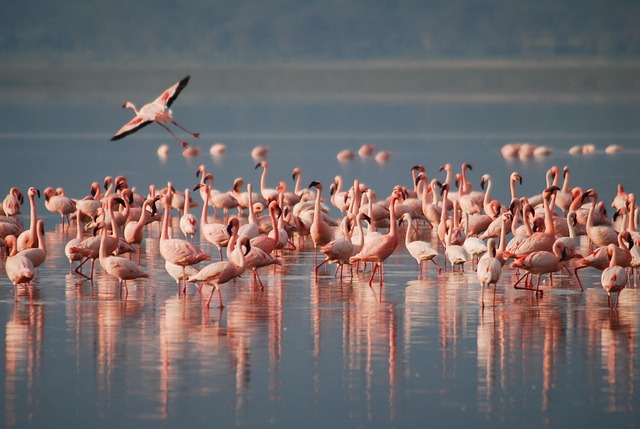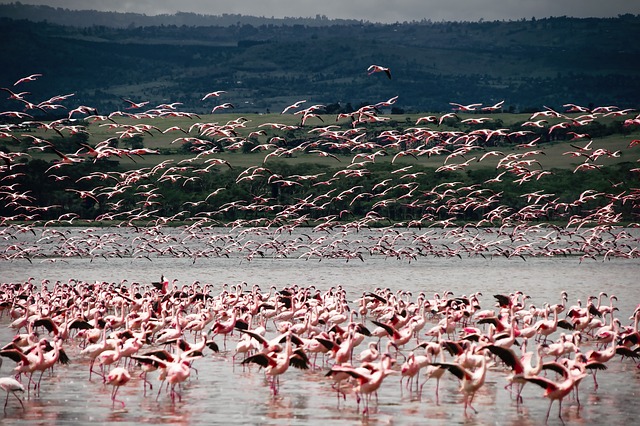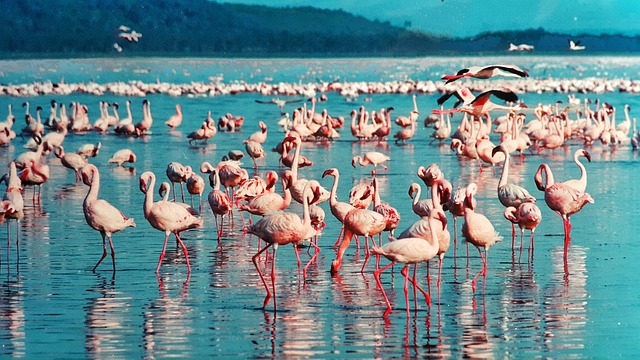Welcome to the world of flamingos – the fascinating and flamboyant birds that have captured the hearts of people around the world. From their distinctive pink feathers to their unique social behaviors, flamingos have become a popular icon in popular culture.
In this article, we will delve deeper into the life of flamingos and explore their physical appearance, social behaviors, diet, mating rituals, and conservation efforts.
Join us as we discover the wonders of these beautiful creatures and debunk some common misconceptions along the way.
Physical Appearance and Habitat
Flamingos are easily recognizable birds with their vibrant pink feathers and long, slender legs. They are known for their unique physical appearance, which has made them a popular subject in art, fashion, and pop culture. These fascinating birds are found in various parts of the world, from Africa to the Caribbean, and are a common sight in zoos and wildlife reserves.

There are six different species of flamingos, each with its own distinct appearance and habitat. The Greater Flamingo, also known as the Caribbean Flamingo, is the largest and most widespread species. They are found in the Caribbean, South America, and parts of Africa. The Lesser Flamingo is the smallest species and can be found in sub-Saharan Africa and India. Other species include the Andean Flamingo, Chilean Flamingo, James’s Flamingo, and the American Flamingo.
One of the most striking features of flamingos is their beautiful pink feathers. Their feathers are not naturally pink, but it is the result of their diet, which is rich in carotenoids, a type of pigment found in algae and small crustaceans. Flamingos are also known for their long, thin legs, which can measure up to four feet in length. These legs are specially adapted to help them wade through shallow waters and navigate through muddy terrain.
Flamingos are typically found in wetland areas such as salt lakes, lagoons, and estuaries. They are highly adaptable birds and can survive in a range of habitats, from tropical areas to cold, high altitude regions. They are known to migrate to different locations depending on the availability of food and suitable breeding conditions.
Apart from their distinctive physical appearance, flamingos have several unique adaptations that allow them to thrive in their habitats. For example, their long, curved beaks are specialized for filter feeding. They use their beaks to scoop up water and then filter out small aquatic animals and algae. This feeding technique is essential for their survival as it provides them with the necessary nutrients to maintain their vibrant feathers and overall health.
Flamingos are also known for their distinctive vocalizations and body language. They communicate with each other through a variety of sounds, including honks, grunts, and growls. They also use their beaks, necks, and wings to convey different messages to their flock members. These communication methods are crucial for maintaining social bonds and establishing dominance within the flock.
The social behavior of flamingos is also a notable aspect of their physical appearance and habitat. These birds are highly social and typically live in large flocks, sometimes consisting of thousands of individuals. Living in a group provides them with protection from predators and allows them to work together to find food and suitable breeding sites. Within the flock, flamingos also form smaller subgroups based on age, gender, and breeding status.
In conclusion, flamingos are fascinating birds with unique physical appearances and adaptable habitats. Their vivid pink feathers, long legs, and specialized feeding techniques make them stand out in the animal kingdom. Their social behavior and communication methods also play a crucial role in their survival. As we continue to learn more about these magnificent creatures, it is essential to remember the importance of conserving their habitats and respecting their natural behaviors.
Social Behavior and Communication
Flamingos are not just known for their distinctive pink feathers and graceful long legs, but also for their highly social nature. These birds are often seen living in large flocks, sometimes consisting of thousands of individuals. This social behavior is crucial for their survival and plays a significant role in their communication and reproduction.
One of the most fascinating aspects of flamingos’ social behavior is their ability to form strong bonds with their flock members. These bonds are formed through various activities such as preening, dancing, and synchronized movements. Flamingos are known for their elaborate courtship displays, where they perform synchronized group movements, showcasing their physical abilities and attracting potential mates.
In addition to physical displays, flamingos also communicate through vocalizations and body language. Their vocalizations consist of honks, grunts, and wails, which they use to convey different messages to their flock members. For example, a loud honk may indicate a warning of danger, while a soft grunt may be a way of greeting.
Body language is also a crucial form of communication for flamingos. They use their long necks and heads to create different postures and gestures, which can convey different meanings. For instance, a head held high may signify dominance, while a head tucked under the wing may indicate rest.
Another intriguing aspect of flamingos’ social behavior is their ability to synchronize their movements. This synchronization is not only seen during courtship displays but also during their feeding and resting activities. Flamingos often form a circle or line formation while feeding, which helps them to protect their young and maintain a safe distance from predators.
Apart from communication and bonding, social behavior also plays a significant role in flamingos’ survival and reproduction. Living in large flocks provides them with a better chance of finding food and avoiding predators. It also helps them to conserve body heat during colder weather by huddling together in a group.
Furthermore, when it comes to reproduction, flamingos exhibit a unique parenting behavior. Once a pair has successfully mated, both the male and female take turns incubating the eggs, each for a specific period. This shared responsibility in raising their young shows the strong bond and commitment between mates.
In addition to their social behavior, flamingos also have a unique way of communicating with their young. They often form creches, where young flamingos are left in the care of a group of adults while their parents are out foraging. This behavior allows the parents to focus on finding food while the young are kept safe with the group.
Sadly, flamingos, like many other species, are facing threats to their survival, such as habitat loss and pollution. However, efforts are being made to conserve these magnificent birds, such as establishing protected areas and raising awareness about responsible tourism.
In conclusion, flamingos’ social behavior and communication are essential aspects of their fascinating lives. Their ability to form strong bonds, communicate through various means, and synchronize their movements is crucial for their survival and reproduction. By understanding and appreciating these behaviors, we can continue to admire and protect these beautiful birds for generations to come.
Diet and Feeding Habits
The diet and feeding habits of flamingos are truly unique and fascinating. As we mentioned earlier, these birds primarily feed on algae and small aquatic creatures. However, the way in which they obtain their food is what sets them apart from other bird species.
Flamingos have a specialized beak that is designed for filter feeding. This means that they are able to filter small organisms and algae from the water through their beak. They use their long legs to wade through shallow water and use their beak to scoop up mud and water, then filter out their food with their specialized beak. This adaptation allows them to thrive in their habitat, even in environments with low food availability.
Interestingly, flamingos can eat upside down, with their heads submerged in water and their beaks pointed towards the sky. This is because their beak is designed to function in any direction, allowing them to reach their food in different positions.

In addition to their unique feeding behavior, flamingos also play an important role in maintaining the balance of their ecosystem. As they feed on algae, they help prevent overgrowth and maintain water quality. They also stir up the water with their feet, which helps nutrients to circulate and benefit other aquatic creatures.
When it comes to their diet, flamingos are not picky eaters. They will consume a variety of small invertebrates such as crustaceans, mollusks, and insects, along with algae and plant matter. In fact, the pink color of flamingos’ feathers is a result of the carotenoid pigments found in the algae and crustaceans they consume.
To meet their nutritional needs, flamingos spend a significant amount of time feeding. They can consume up to half of their body weight in one day, and they often feed in large groups which allows them to find food more efficiently.
Their feeding habits also change depending on the season. During breeding season, flamingos may consume more protein-rich foods such as insects and small fish to support their reproductive efforts.
Overall, the feeding habits of flamingos play a crucial role in maintaining the delicate balance of their habitat. The unique adaptations and behaviors of these birds allow them to thrive in their environment and contribute to the ecosystem in significant ways.
To summarize, flamingos have a specialized diet of algae and small aquatic creatures, which they obtain through filter feeding using their unique beak. They play an important role in their ecosystem by maintaining water quality and nutrient circulation. Their feeding habits change depending on the season and they consume a variety of foods to meet their nutritional needs. Next, we will explore the fascinating mating and reproduction habits of flamingos.
Mating and Reproduction
Flamingos are known for their vibrant pink feathers and graceful movements, but their mating and reproduction habits are just as fascinating. These birds have unique behaviors and rituals that ensure the continuation of their species. In this section, we will take a closer look at the mating and reproduction process of flamingos.
Mating rituals among flamingos are elaborate and involve both male and female birds. To attract a mate, male flamingos perform a series of courtship displays, including head flagging, wing salutes, and synchronized dance-like movements. These displays not only showcase the male’s physical abilities but also serve as a way to communicate their readiness to mate.
Once a male and female flamingo have paired up, they begin to build their nest together. The nest is usually a mound of mud or sand, shaped like a cone, and can be up to 20 inches tall. It serves as a safe place for the female to lay her eggs and for the male to protect them.
Flamingos have a unique way of incubating their eggs. Unlike most birds, flamingos use their feet to incubate their eggs, standing on one leg while tucking the other under their body. This allows the bird to conserve body heat and protect the eggs from predators. Both male and female flamingos take turns incubating the eggs, showing a strong sense of partnership and cooperation.
After about 28 days, the eggs hatch, and the fluffy chicks emerge. The parents work together to feed and protect their young, often forming creches, or nurseries, with other flamingo parents to look after their chicks. This cooperative behavior not only helps the chicks survive but also allows the parents to take turns feeding and resting.
As the chicks grow, they develop their signature pink feathers, which are initially white or grey. It takes about two months for the chicks to fully develop their pink plumage, and during this time, they stay close to their parents, learning vital survival skills from them.
Flamingos are known for their long lifespan, with some species living up to 50 years in the wild. They do not reach sexual maturity until they are 3-4 years old, and they only breed every one to two years. This slow reproductive rate, combined with habitat loss and human interference, makes it challenging for flamingos to maintain healthy populations.
Conservation efforts have been put in place to protect the flamingo’s habitats and breeding areas, and responsible tourism practices play a crucial role in this. However, flamingos are still facing threats such as pollution, habitat destruction, and disturbance of breeding sites. It is vital to continue educating ourselves and others about these magnificent birds and the importance of conservation efforts.
In conclusion, the mating and reproduction habits of flamingos demonstrate the strong bonds and cooperation between these birds. From elaborate courtship displays to shared responsibilities in parenting, flamingos have a unique way of ensuring the survival of their species. By understanding and appreciating these behaviors, we can further our efforts to protect and conserve these fascinating creatures for generations to come.
Threats and Conservation Efforts
Despite their widespread recognition and popularity, flamingos are facing numerous threats that jeopardize their survival. One of the major threats to flamingos is habitat loss due to urban development, agriculture, and pollution. This has led to a decline in their population and the loss of important breeding sites.
However, there are efforts being made to conserve flamingo populations and their habitats. Many countries have established protected areas where flamingos can thrive without disturbance. Conservation organizations also work to monitor and protect flamingos, as well as educate the public about the importance of these birds in maintaining a balanced ecosystem.

In addition, responsible tourism plays a crucial role in the conservation of flamingos. By supporting eco-friendly and sustainable tourism practices, visitors can help minimize the negative impact on flamingo habitats and contribute to their conservation efforts.
Misconceptions and Fun Facts
Despite their widespread recognition and popularity, there are still many misconceptions and little-known facts about flamingos. These fascinating birds have captured the imaginations of people all over the world, but there is often more to them than meets the eye. In this section, we will address some of the common misconceptions about flamingos and share some fun and interesting facts that will surely amaze you.
Misconception: Flamingos are always pink.
Fact: While it is true that flamingos are known for their vibrant pink feathers, not all of them are actually pink. The color of a flamingo’s feathers is determined by their diet, specifically the amount of carotenoids they consume from their food. Flamingos that have access to a diet rich in carotenoids will have a brighter and more vibrant pink hue, while those with a diet lacking in these pigments may have paler feathers or even white feathers.
Misconception: Flamingos can only stand on one leg.
Fact: Flamingos are often seen standing on one leg, but this does not mean that they can only stand in this position. In fact, they are able to stand on both legs and will do so when they are resting or sleeping. The reason they stand on one leg is to conserve body heat. By tucking one leg up against their body, they reduce the amount of heat lost through their legs, which is important for their survival in colder environments.
Misconception: Flamingos are aggressive birds.
Fact: Despite their striking appearance, flamingos are actually quite peaceful birds. They rarely engage in physical fights and instead use vocalizations and body language to communicate with each other. The only time they may become aggressive is during the breeding season when competition for mates and nesting sites increases. Even then, their displays of aggression are mainly for show and rarely result in physical harm.
Fun Fact: Flamingos are excellent dancers.
While their elaborate courtship displays may seem like just a way to attract a mate, flamingos are actually quite skilled dancers. They will perform synchronized movements with their flock mates, swaying and twirling in unison. These displays not only help them find a mate but also serve as a way to strengthen social bonds within the flock.
Fun Fact: Flamingos have a unique way of feeding.
As mentioned earlier, flamingos primarily feed on algae and small aquatic creatures. However, they have a unique way of obtaining their food. They use their specialized beaks to filter out food from the water, similar to how a whale filters out krill. This method of feeding allows them to consume large amounts of food quickly, which is necessary for their survival in their often harsh and unpredictable environments.
Fun Fact: Flamingos are expert flyers.
Despite their somewhat awkward appearance on land, flamingos are expert flyers. They are capable of flying long distances, with some species even migrating thousands of miles. Their long and slender wings allow them to soar through the air with ease, reaching speeds of up to 35 miles per hour.
From their unique physical appearance to their interesting behaviors and adaptations, flamingos are truly one-of-a-kind birds. And despite their widespread recognition, there is still so much to learn and appreciate about them. So the next time you see a flamingo, remember these misconceptions and fun facts, and you will surely see these beautiful birds in a whole new light.
